Introduction
One of the most important components of a productive and healthy workplace is performance reviews.
Employers and those evaluating employees’ performance may, unfortunately, experience severe anxiety and stress throughout the review time.
While managers must balance several performance reviews and inform upper management of the evaluation process’s findings, employees fear subpar performance.
However, what if I told you that there is a method to decrease the stress of your upcoming employee review process while maintaining uniformity for all parties involved?
Performance review templates help ensure that your review process is efficient and offer much-needed assistance.
In addition to offering you twelve free performance review templates, this blog post will address some often-asked issues regarding the purpose and methodology of conducting effective performance reviews.
Performance review template: What is it?
An organization’s tool for assessing a worker’s performance is a performance review template. Typically, it includes pre-planned sections for prompts and questions that address several facets of an employee’s work performance.
Your standard employee review template might, for instance, review the worker’s:
- Duties associated with the job,
- Future objectives,
- Advantages,
- Areas that require improvement, and
- Ratings of overall performance.
Additionally, performance evaluation templates can have sections for:
- Remarks, and
- Constructive criticism.
Time is saved and evaluation uniformity and fairness are guaranteed when performance review templates are used.
However, fostering a culture of communication on the job is essential to a productive employee evaluation. Selecting an employee communication tool that completely meets your communication needs will therefore position you for the future.
Templates for performance reviews
We have 12 templates ready for you for free right now. You can modify them to suit your needs.
Before we start off, let’s talk about performance evaluation templates.
1. Yearly performance review template
Many businesses and sectors utilize annual performance evaluations to evaluate employees’ work over a one-year period.
Because of this, they are typically designed to talk about broad objectives, successes, and difficulties rather than offering a thorough evaluation of a worker’s performance.
The following areas are covered by the yearly performance review template that we have created:
- Job knowledge,
- Communication skills,
- Work quality,
- Initiative,
- Teamwork, and
- Overall performance.

2. Performance Review Template: Quarterly
Every three months, at the conclusion of the quarter, there is a performance evaluation.
Compared to annual reviews, quarterly evaluations of performance provide more frequent input, but they are less intrusive than monthly reviews. Without having to wait an entire year to evaluate an employee, a three-month evaluation gives ample opportunity to examine performance in a broader range.
We have included the following areas in our quarterly performance evaluation template:
- Goals progress,
- Work quality,
- Communication skills,
- Challenges faced,
- Team collaboration,
- Improvement areas,
- Strengths, and
- Overall performance.

3. Performance review template: Monthly
Monthly reviews provide more regular opportunities to talk about employees’ performance than annual and quarterly reviews.
- Professional goals,
- Improvement areas,
- Recent achievements, and
- Job challenges.
An excellent intermediate option between weekly and quarterly evaluations is a monthly review.
With monthly reviews, you can use a numerical evaluation system or conduct a qualitative performance assessment.
Both of these forms of evaluation can be carried out with our performance review template. The “performance review” sections can be used to include explanations of the worker’s performance or numerical ratings.
You can include any additional views you may have regarding various performance categories in the “comments & feedback” areas, even if you only include number-related information.
For this reason, the following areas are covered by our monthly performance evaluation template:
- Goals progress,
- Completed tasks,
- Work quality,
- Team collaboration,
- Communication skills,
- Challenges faced,
- Improvement areas,
- Strengths, and
- Overall performance.
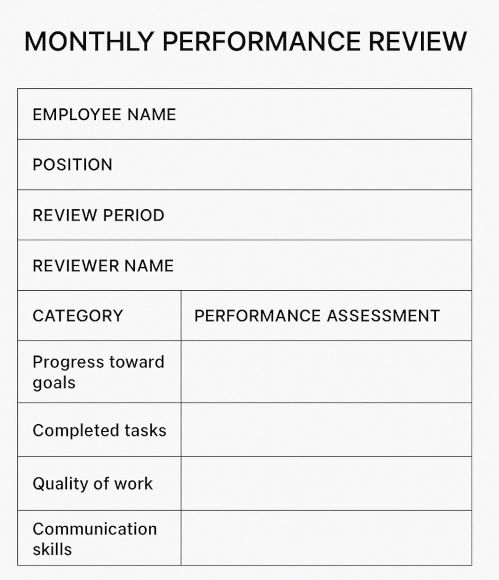
4. Performance review template: Weekly
More quick feedback is given during weekly performance evaluations, which also enable continuous goal-setting and mentorship.
Usually conducted as quick check-ins or individual meetings, these assessments are more casual and include challenges, successes, and progress.
These check-ins are primarily intended to keep everyone informed and monitor progress, not to grade performance.
The following are some ideas and prompts for subjects you can discuss in those check-in meetings that are included in the weekly performance evaluation template:
- Goals progress,
- Upcoming tasks,
- Performance feedback,
- Challenges & solutions,
- Appreciation and recognition, and
- Collaboration and communication.
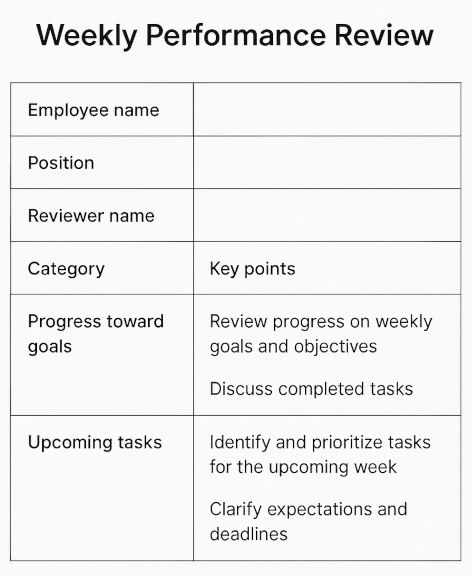
5. Performance review template: Simple
You may always undertake a basic performance review using a number rating scale if you don’t want to detail the worker’s evaluation too much.
With a scale of one to five, you may assign ratings to your staff in a variety of categories with our straightforward performance review template, including:
- Attendance,
- Productivity,
- Punctuality,
- Teamwork,
- Independence,
- Communication,
- Task prioritization,
- Work quality,
- Initiative,
- Policy adherence,
- Overall performance.
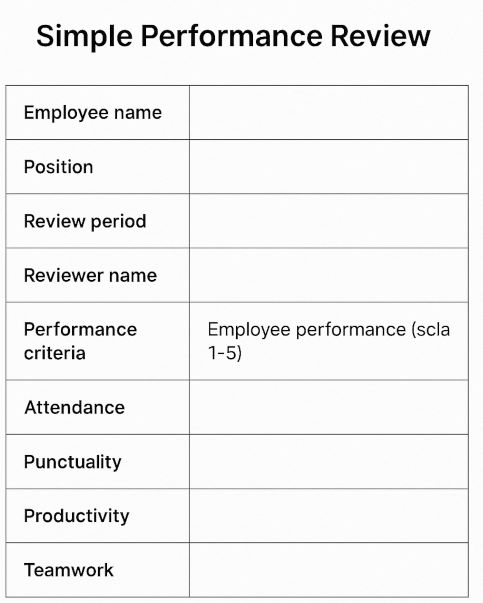
6. Performance review template: 90-day
A three-month onboarding phase typically concludes with a 90-day performance evaluation.
It emphasizes the application of job-related knowledge and abilities, organizational changes, and the onboarding process.
Sections covering the following criteria are included in our ninety-day performance review template:
- Job knowledge,
- Organizational adjustment,
- Performance,
- Company culture,
- Team collaboration,
- Overall performance.
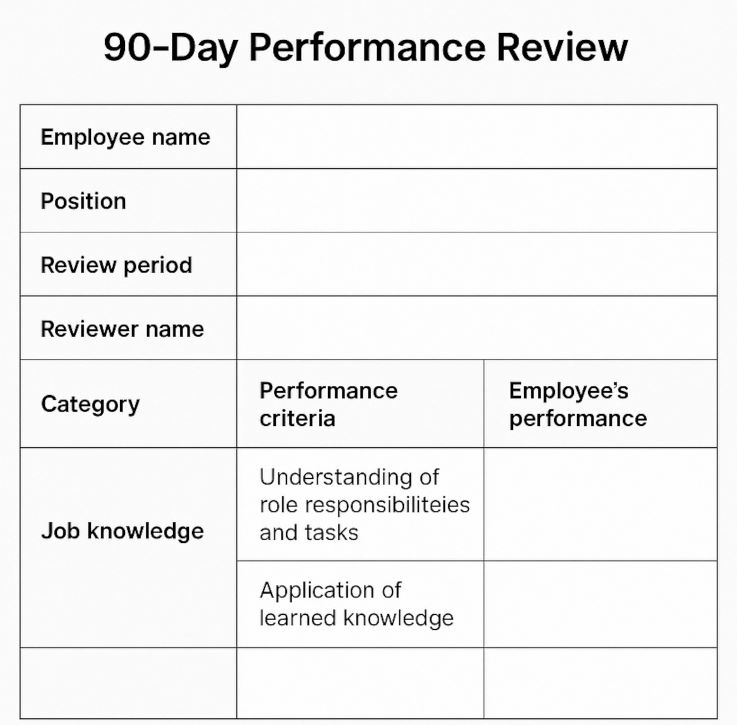
7. Performance review template: 30-60-90
Companies may also adopt a 30-60-90-day performance review procedure for onboarding new hires.
This assessment method is based on check-ins conducted after the first thirty, sixty, and ninety days of the fresh hire’s employment, as the name implies. These reviews act as benchmarks to evaluate performance, progress, and organizational integration.
By enabling them to learn about each other’s requirements and expectations and offer pertinent feedback at an early stage of the period of onboarding, the 30-, 60-, and 90-minute performance evaluation helps the company and the employee.
Our performance review template allows you to record your evaluations for each of the three periods in one location. The following categories are part of our worker review template:
- Job knowledge,
- Work quality,
- Communication skills,
- Teamwork,
- Integration,
- Adaptability,
- Overall performance.
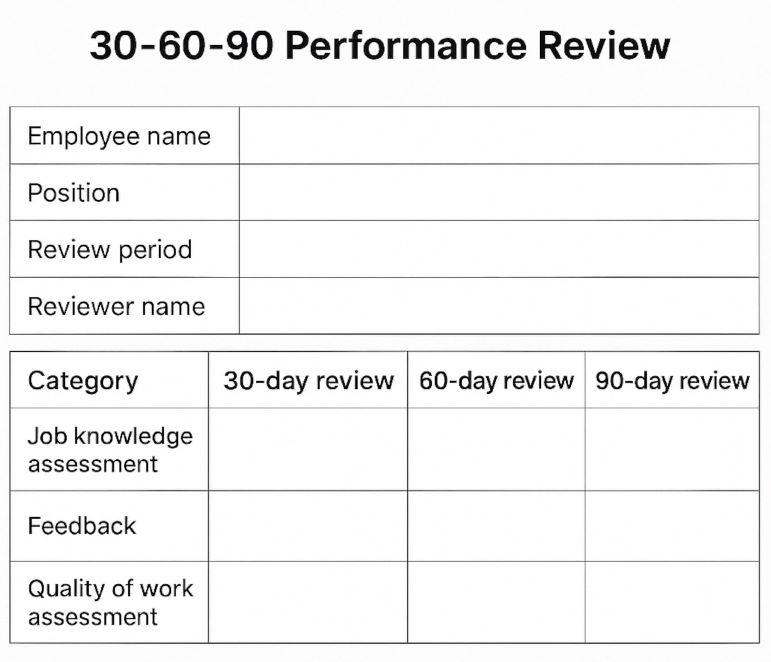
8. Performance review template: 360
An extensive evaluation procedure that collects insightful input on an individual from several sources is called a 360-degree performance review.
A worker’s performance, for instance, may be assessed by their colleagues, direct reports, upper management, and even outside parties like customers and clients in addition to their immediate supervisor.
A 360-degree performance evaluation might be difficult to conduct because of the diverse range of input gathered from various sources. Nevertheless, you can use one of the appropriate performance review templates from this list to get input from those who are able to assess your employees’:
- Job knowledge,
- Team collaboration
- Communication skills,
- Leadership qualities
- Problem-solving,
- Adaptability,
- Work quality,
- Overall performance
Following the return of those evaluation forms, you may use our 360-degree performance review template to generate a summary that draws from three distinct sources, as shown below.
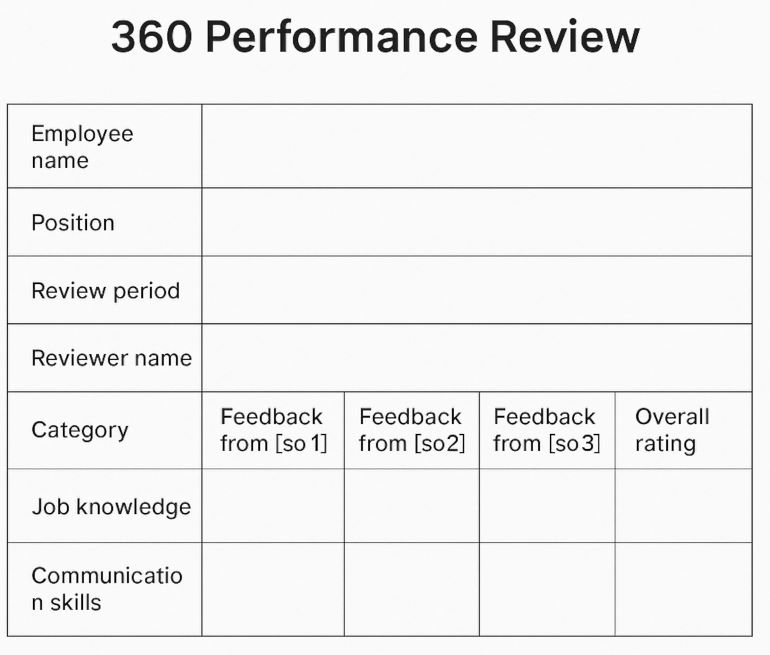
9. Performance review template: Team
The collective performance, accomplishments, and difficulties of a team are evaluated in a team performance assessment.
With a particular emphasis on how they cooperate to accomplish shared objectives, team performance assessments assess the general performance and interactions among a group of people working together.
Team performance reviews can be conducted on a regular basis (quarterly, yearly, etc.) or in reaction to particular initiatives or events. They can be conducted through:
- Organized meetings,
- Questionnaires, or
- Team member evaluations on an individual basis that add to the overall image.
You can evaluate and remark on your team’s performance in a number of areas using our performance review template:
- Goal alignment,
- Collaboration,
- Communication,
- Problem-solving,
- Accountability,
- Decision making,
- Task delegation,
- Productivity,
- Adaptability,
- Innovation,
- Employee and team morale,
- Leadership,
- Overall performance.

10. Performance review template: Employee self-evaluation
A supervisor or manager will typically conduct an employee self-evaluation in conjunction with a formal performance assessment.
A self-evaluation objective is to motivate staff members to:
Think back on their work, take lessons from previous setbacks, and be ready to contribute significantly in the performance review session.
Your staff can evaluate how they performed in the following areas with the use of our performance evaluation template:
- Job knowledge,
- Team collaboration,
- Communication skills,
- Adaptability,
- Problem-solving,
- Work quality,
- Leadership,
- Overall performance.

11. Professional review template: Professional Development
The purpose of a professional development assessment is to assess a person’s potential for professional growth as well as their skill development and progress.
Employees can find areas for development, enhancement of skills, and career promotion with the aid of professional development evaluations, in contrast to typical performance reviews, which mostly concentrate on past performance.
Reviews of professional growth can be carried out on a regular basis (e.g., every year or every two years) or in tandem with yearly performance evaluations.
We’ve created a professional development evaluation template that you can utilize to evaluate an employee’s growth and development potential using the following standards:
- Career goals,
- Improvement areas,
- Strengths,
- Skill development,
- Training needs,
- Mentorship/coaching,
- Professional networking,
- Work-life balance,
- Career progression,
- Development plan.

12. Professional review template: Compensation
An assessment of the pay and benefits offered to employees is called a compensation review.
Analyzing data such as corporate budget, personnel performance, and market trends is usually required to ascertain the proper:
- Salary,
- Benefits,
- Bonuses,
- Incentives,
- Other types of compensation.
Keeping employees happy and trusting requires openness and good communication regarding the reasoning behind pay decisions.
You may make a knowledgeable decision on your employee’s pay and benefits by using our remuneration review template, which gathers data on:
- Market trends,
- Adjustment for Cost of living,
- Employee performance,
- Organizational budget,
- Career development,
- Equity & fairness,
- Current benefits evaluation,
- Current compensation evaluation,
- Other factors (such as certifications, special skills, certifications),
- Future plan of action

A performance review template’s benefits
While employee assessments can be a difficult process for all parties, you can make the subsequent review period more manageable by using performance review templates.
First of all, templates provide uniformity by giving every review a consistent format and an organized framework. Each worker is treated fairly and assessed using the same standards thanks to this uniformity.
Secondly, by employing a worker review template, managers may concentrate entirely on precisely assessing the work of their staff members.
By modifying the performance evaluation template to better fit their organization, managers and human resources professionals can avoid creating review questions from the start and instead concentrate on:
- Setting objectives,
- Giving insightful criticism, and
- Identifying areas that require improvement.
In the end, a predetermined template with specific and pertinent elements will yield in-depth and significant assessments that are advantageous to the company and its employees.
In essence, performance review templates maintain a clear and effective evaluation process.
Managers can concentrate on pertinent performance aspects without becoming bogged down in extraneous details when they use predetermined sections & prompts. As a result, reviews are thorough but succinct, and goals and areas for development are easily understood.
Writing a performance review: What to include
A fair evaluation of the worker’s performance is essential for performance reviews to be accurate and pertinent. A thorough performance evaluation is necessary for it to be accurate and beneficial, as per Aleksandra Babic, a human resources specialist at CAKE.com:
“It’s critical to consider multiple perspectives while assessing an employee’s performance. Don’t limit your attention to issues that require development; also highlight their successes and outstanding performance examples.”
In light of this, the following should be included in your evaluation to ensure balance:
- Evaluation of performance: Compare the worker’s performance to predetermined standards, including teamwork, communication skills, job knowledge, and work quality.
- Achievements: Emphasize the worker’s noteworthy contributions and successes during the review period.
- Identify areas for improvement: Use feedforward to provide examples of areas where the staff member can improve.
- Goal setting: S.M.A.R.T. goals should be set in order to improve in the future.
- Encouraging feedback: Using sympathetic communication, incorporate positive reinforcement into your constructive criticism.
- Scaling system: You might be able to utilize a numerical scoring system for some criteria, but you might need to be descriptive for others. Avoid the tendency of assigning a number to everything.
Lastly, Babic pointed out that it’s critical to maintain professionalism and civility in our assessments, just like in any other professional communication:
“When assessing an employee’s performance and communicating the findings, keep in mind to be impartial, equitable, and courteous. It is possible and desirable to convey terrible news in a courteous and professional way.”
Frequently Asked Questions
Following your analysis of the hows and whys of performance evaluations, you might have some further questions.
The following contains our responses to some of the most common queries regarding performance reviews.
1. What are performance reviews used for?
Performance evaluations are used to evaluate and then improve employee performance.
It’s an event to:
- Establish goals for growth,
- Give feedback, and
- Match the manager’s or the organization’s expectations with those of the employee.
2. How frequently should the performance of employees be reviewed?
The frequency of performance evaluations will be determined by your organization, even though they should be done on a regular basis.
In general, the best frequency of assessments may vary depending on the type of work you do, the requirements of your business, and industry norms.
Still, the following are the most typical performance review intervals:
- Every year,
- Semi-annually,
- Every quarter, or
- Every month.
The objective is to facilitate employee development and give timely feedback, so schedule your evaluations appropriately.
As long as you notify your organization of any changes promptly, you can always alter the review timetable if you discover that it doesn’t work out for your business.
3. How can an employee get ready for a performance review?
As a staff member, you have the power to shape the outcome of your performance review by accepting responsibility for your own work and growth.
It turns out that your manager will have an easier time if you are ready for a performance review.
Therefore, if you wish to be completely covered, you can:
- Consider your accomplishments and performance.
- Consider the difficulties you’ve encountered,
- Determine your strengths and places for improvement.
- Prepare supporting details and examples for your assertions, and
- Prepare pertinent responses in advance of any questions you might be asked.
But try not to get anxious about performance reviews.
Take a positive approach to them and make it your goal to develop and discover more about yourself. In the end, employee assessments provide you the chance to show your dedication to professional growth and learn how to take constructive criticism.
Make the most of your performance reviews because they ultimately assess your work and help you improve as a person.
4. How can I, as a manager, give poor performance review results?
As a leader, you must acknowledge that not all team members will be given favorable employee evaluations.
As a result, you will most likely eventually need to talk about team members’ inadequate performance evaluation results.
Even though nobody likes having those uncomfortable talks, you may render them less uncomfortable for everyone. You should do the following before attending that meeting:
- Get well-prepared and compile precise examples and proof to back up your conclusion.
- Commence with compliments by praising the staff members’ abilities and contributions.
- Avoid making remarks about an employee’s personality or traits and instead concentrate on their behavior. Remain focused on their performance and activities when providing feedback.
- When discussing how a worker’s performance is lacking, be straightforward. Give concrete instances to support your arguments.
- Encourage your staff by giving them the tools and assistance they need to address their areas for growth.
Most importantly, you should be professional and sensitive in your approach, and make an effort to actively listen to the employee’s viewpoint.
Babic offers yet another helpful piece of advice on how to deal with a poor performance evaluation outcome. She specifically stresses the significance of picking the appropriate moment and location to break bad news:
“When and how they break negative news should be carefully considered by managers. The employee should only be consulted one-on-one when discussing poor performance evaluation results. You may publicly acknowledge accomplishments and give your staff members credit, but keep the unfavorable comments to yourself.”
You should concentrate on figuring out how to help everyone on your staff reach their potential even if you have to present poor performance review findings.
What is a plan for performance improvement?
A document known as a PIP (performance improvement plan) outlines the particular areas in which an employee’s performance fell short of expectations.
This document also outlines the actions that workers must take in order to enhance their productivity.
Typically, a performance improvement strategy consists of:
- Explicit instances of subpar performance,
- Measurable aims and goals for progress,
- Schedules for accomplishing these objectives,
- Resources required to enhance performance, and
- Repercussions for failing to improve performance within the allotted period.
Poor performance reviews are typically followed by the implementation of performance improvement initiatives. However they are usually determined by how serious and persistent the performance problems are, and they also heavily rely on the industry as well as the organization’s internal policies and procedures.











































